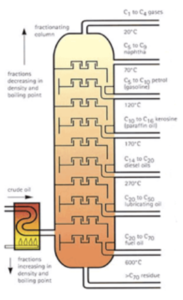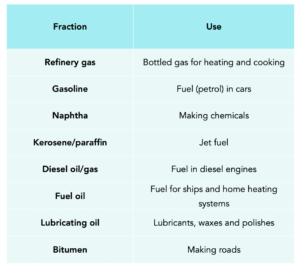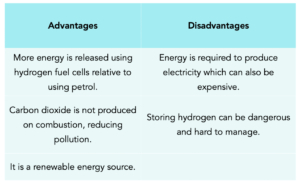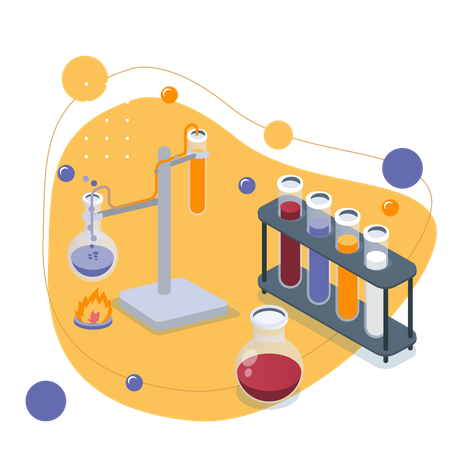Separating Crude Oil (GCSE Chemistry)
Separating Crude Oil
Separating Crude Oil
Fractions and Their Uses
- Lots of compounds make up crude oil. As previously mentioned, crude oil is made up of various hydrocarbons. These can be separated by a process called fractional distillation, into fractions.
- Within a fraction, molecules contain a similar numbers of carbon atoms. When crude oil gets separated into fractions, similar molecules group together. Usually, molecules group together by the number of carbon atoms that they contain. Therefore, each fraction consists of molecules with a similar number of carbon atoms.
- Fractions can be processed. Once the fractions are separated out of the crude oil mixture, they can be processed. The processed fractions can then be used to produce fuels and feedstock for the petrochemical industry.
The Process of Fractional Distillation
For exams, you are expected to be able to describe the process of fractional distillation.
- Crude oil is heated. The liquid crude oil is heated within a chamber, to about 350 – 400 °C, until most of it evaporates and forms a gas. Any liquid is drained off as the crude oil gas enters the fractionating column.
- A temperature gradient is set up in the fractionating column. The bottom of the fractionating column has the highest temperature and the top of the column has the lowest temperature.
- Long hydrocarbons condense first. The longest hydrocarbons have higher boiling points. This is because there are more weak intermolecular forces between the molecules, as they are larger. More energy is needed to separate the molecules. Larger molecules will cool and condense and turn into liquids at higher temperatures, at the bottom of the column.
- Short hydrocarbons condense last. The shorter hydrocarbons have lower boiling points. They have fewer weak intermolecular forces so less energy is needed to separate the molecules. Shorter hydrocarbons remain as gases until they reach the top of the column where it is cooler; they cool and condense here.

- Different boiling points are utilised. Throughout the process of fractional distillation, the different boiling points of hydrocarbons are utilised. Depending on their boiling points, different fractions are formed at different levels of the column.
- Evaporation and condensation are key processes in fractional distillation. At the beginning of the fractional distillation process, crude oil is heated and most of it evaporates. It enters the fractionating column as a gas. As the gas rises up the column, the crude oil fractions cool and condense out at different levels, depending on their boiling points.
- Fractions can be used as fuels. Each fraction has different properties due to the length of the carbon chain. Therefore, we can use each fraction for different purposes. The shortest chain hydrocarbons are used for petroleum gas and petrol. Those with the longest chains can be used for heavy fuel oil and as bitumen for road making.
Crude Oil Products
The Petrochemical Industry
- Hydrocarbons can form new compounds. Hydrocarbons from crude oil are used in the petrochemical industry as feedstock in order to make new compounds. These new compounds can form polymers, solvents, lubricants and detergents.
Natural and Synthetic Carbon Compounds
- Carbon can form different compounds. Due to its structure and bonding, carbon can form various compounds which have different properties. Compounds with similar properties can form a homologous series. For example, alkanes are a homologous series.
Uses of Fractions
You may be asked about the different names of fractions and their uses, seen in the table below. As you move down the table, the molecules increase in size and therefore have a higher boiling point and are not very volatile. This means they will not flow or ignite as easily. You can relate these properties to the uses of each fraction.

Using Hydrogen in Cars
There are several advantages and disadvantages to using hydrogen as a fuel in cars, rather than petrol. This can be summarised in a table as seen below:

Crude oil is a fossil fuel that is composed of various hydrocarbons and other organic compounds. It is found underground and is extracted for use as a fuel source.
The purpose of separating crude oil is to separate its various components into more useful, pure substances. This allows the different components to be used for different purposes, such as gasoline, diesel fuel, and kerosene.
Crude oil is separated using a process called fractional distillation. This process involves heating the crude oil to produce vapor and then cooling the vapor to separate the different components based on their boiling points.
The different components of crude oil include gases such as methane and ethane, liquids such as gasoline and diesel fuel, and solids such as asphalt. The exact composition of crude oil varies depending on the source of the oil.
Fractional distillation is a process where a mixture of liquids is separated into its individual components based on their boiling points. In the case of crude oil, it is heated to produce vapor, which is then cooled and separated into different components.
The benefits of separating crude oil include being able to produce more useful, pure substances from the oil, such as gasoline, diesel fuel, and kerosene. This allows the different components to be used for different purposes, improving the overall efficiency of using crude oil as a fuel source.
The efficiency of separating crude oil can be measured by determining the amount of each component produced from a certain amount of crude oil. This can be expressed as a percentage of the total amount of crude oil used.
The environmental impacts of separating crude oil can include air pollution from the emissions produced during the fractional distillation process and the release of greenhouse gases during the use of the products produced from the crude oil. Additionally, the extraction and transportation of crude oil can have negative impacts on the environment.






Still got a question? Leave a comment
Leave a comment